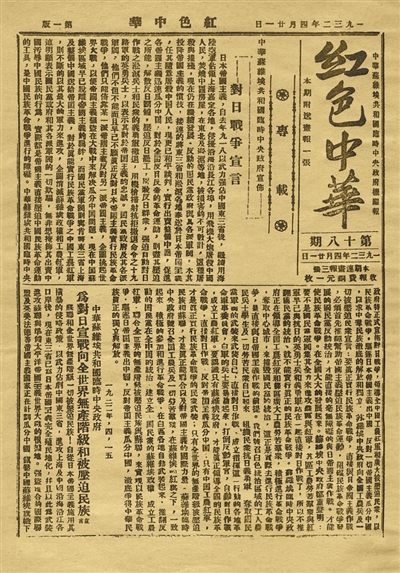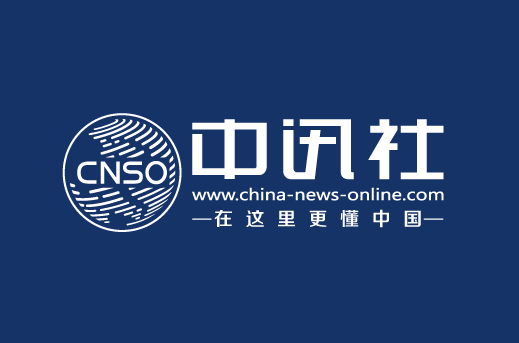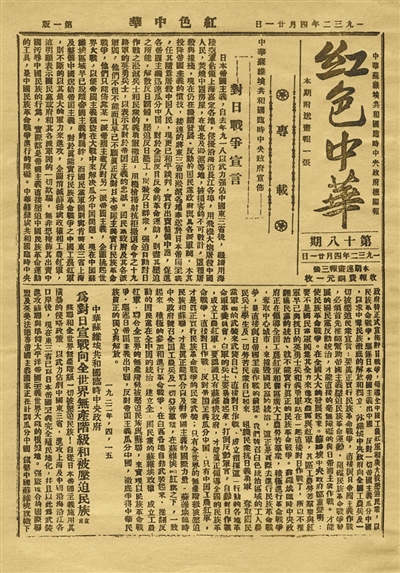
In 1931, Japanese militarism brazenly launched the September 18th Incident. The Chinese people rose up to resist among the white mountains and black waters, becoming the starting point of the Chinese people's War of Resistance Against Japanese Aggression, and at the same time opened the prelude to the world anti-fascist war.
On April 15, 1932, the Provisional Central Government of the Chinese Soviet Republic announced a declaration of the war against Japan, calling for "expressing Japanese imperialism from China through the national revolutionary war."
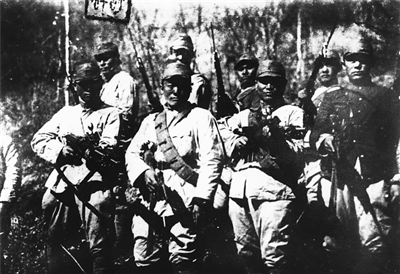
The Northeast Anti-Japanese Allied Forces led by the Communist Party of China insisted on fighting in Baishan and Hei River. As of the autumn of 1937, it developed to more than 30,000 11 troops. The picture shows some soldiers of the Northeast Anti-Japanese Allied Forces.
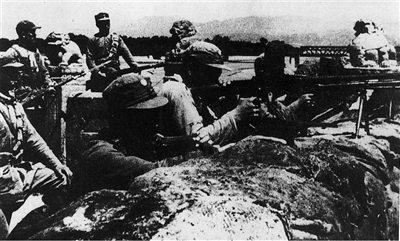
In 1937, the Japanese invaders deliberately created the July 7 Incident and launched a full-scale war of aggression against China. Chinese military and civilians resisted the Japanese invaders tenaciously. China thus entered the stage of national resistance and opened up the main battlefield in the East of the world anti-fascist war. The picture shows the Chinese army fighting back against the invading Japanese army.
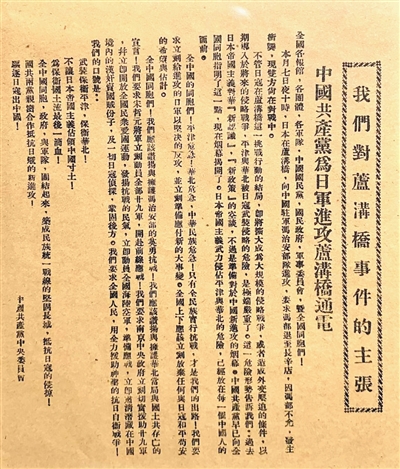
The day after the July 7 Incident, the Central Committee of the Communist Party of China issued a telegram, appealing to the people of the whole country: "Ping and Tianjin are in crisis! North China is in crisis! The Chinese nation is in crisis! Only the whole nation implements the war of resistance is our way out!" The picture shows "The Communist Party of China connects the telegram for the Japanese army to attack Lugou Bridge."
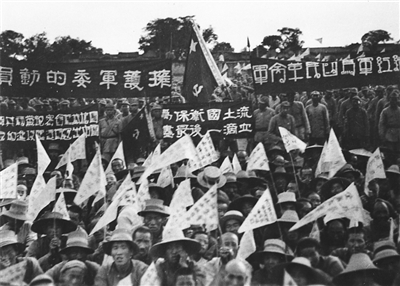
After the outbreak of the national war of resistance, the main force of the Red Army was reorganized into the Eighth Route Army, and the Red Army guerrillas in the eight southern provinces were reorganized into the New Fourth Army (except the Red Army guerrillas in Qiongya). The Kuomintang army tenaciously resisted the Japanese attack, and the people's anti-Japanese armed forces led by the Communist Party of China implemented a strategy behind enemy lines to open up a battlefield behind enemy lines. The picture shows the Red Army holding an anti-Japanese oath-taking meeting after its reorganization.
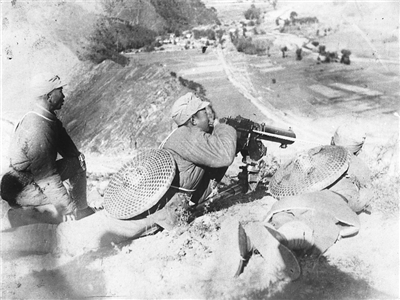
On September 25, 1937, the Eighth Route Army ambushed the Japanese army at Pingxingguan, Shanxi, annihilated more than 1,000 people, each of the 21st Brigade of the 5th Division and the division's baggage unit, seized a large number of military supplies, and achieved a great victory in Pingxingguan, breaking the myth of "invincible" by the Japanese army. The picture shows the 115th Division of the Eighth Route Army ambushing the Japanese army.
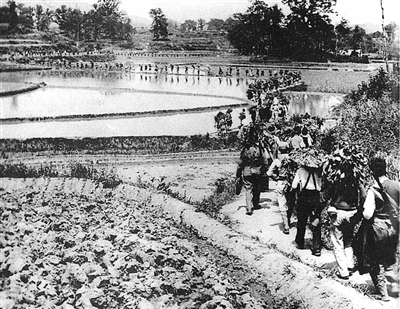
The New Fourth Army advanced into the enemy behind Central China, mobilized the masses widely, carried out anti-Japanese guerrilla wars, created anti-Japanese base areas, and opened up a vast battlefield behind Central China. The picture shows the New Fourth Army advancing behind the enemy.
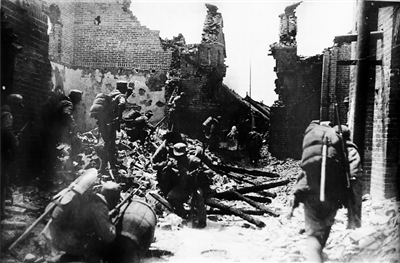
In early 1938, in order to stop the Japanese army from attacking, the Chinese army mobilized troops to launch the Battle of Xuzhou with the Japanese army, and won the Taierzhuang victory in early April. The picture shows the Chinese army and the Japanese army fighting in Taierzhuang.
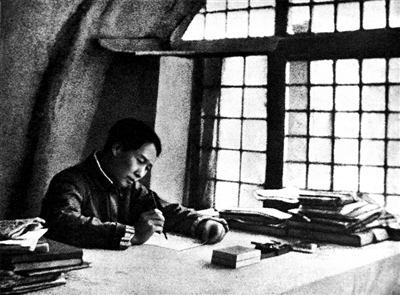
From May 26 to June 3, 1938, Mao Zedong delivered a long speech on "On Protracted War" at the Yan'an Anti-Japanese War Research Association, systematically expounding the general policy of the Communist Party of China's strategic policy on the protracted war against Japan. The picture shows Mao Zedong writing in a cave in Yan'an.
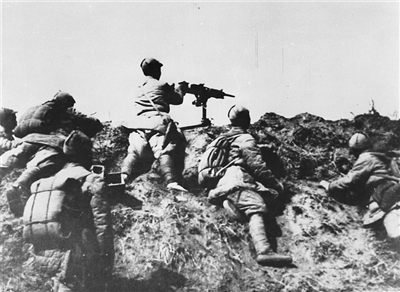
From August 20, 1940 to January 24, 1941, the Eighth Route Army launched a large-scale attack on the Japanese army in North China, and more than 200,000 troops participated in the war, called the Hundred Regiments War, which severely hit the Japanese army's aggression. The picture shows the Eighth Route Army machine gun position during the battle in Shiwan Mountain, Yangquan, Shanxi.
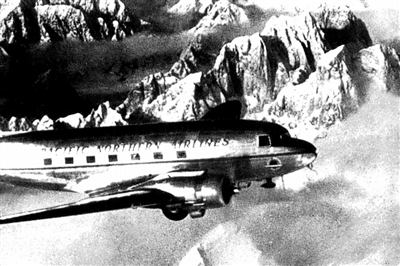
From May 1942 to September 1945, the vast majority of the allied countries' military supplies for aid to China were transported to Kunming from Tingjiang, India via the "Camel Route", and transported more than 800,000 tons of strategic materials to China. The picture shows a C-47 transport plane passing through the snow peaks.
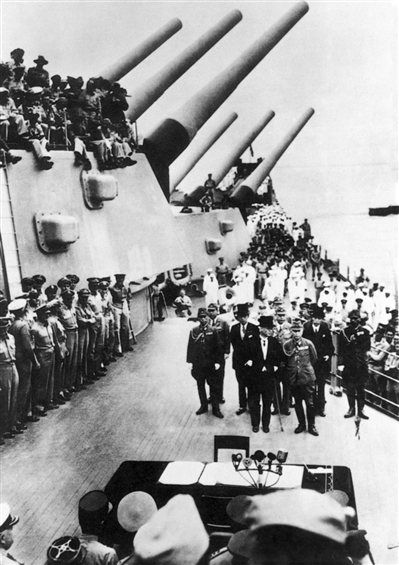
On August 15, 1945, Japan announced its unconditional surrender. On September 2, a signing ceremony for Japan's surrender to the Allies was held on the USS Missouri battleship in Tokyo Bay. The picture shows the signing scene of Japan's surrender.
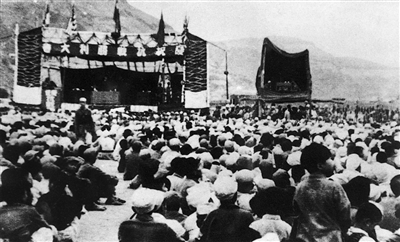
After 14 years of unyielding and bloody battle, the Chinese people defeated the vicious Japanese militarist invaders and achieved a great victory in the Chinese people's War of Resistance Against Japanese Aggression. The picture shows the military and civilians in Yan'an celebrating the victory of the War of Resistance.
On July 7, a ceremony commemorating the 88th anniversary of the outbreak of the national war of resistance was held in the name of the Central Committee of the Communist Party of China, the State Council, and the Central Military Commission, and the opening ceremony of the "For national liberation and world peace - Commemorating the 80th anniversary of the victory of the Chinese People's War of Resistance Against Japanese Aggression and the World Anti-Fascist War" was held at the Memorial Hall of the Chinese People's War of Resistance Against Japanese Aggression and the opening ceremony of the "For national liberation and world peace - Commemorating the 80th anniversary of the victory of the Chinese People's War of Resistance Against Japanese Aggression and the World Anti-Fascist War" was held.
In the arduous and extraordinary War of Resistance Against Japan, all Chinese people fought for the survival of the country, for the national rejuvenation, and for the justice of mankind. The extensive social mobilization, the profound national awakening, the tenacious fighting will, and the firm belief in victory all reached unprecedented heights.
This edition selects some photos of the exhibition with precious historical value. Photos witnessed the Chinese people, together with the people of the world, completely defeated fascism with tenacious will and heroic struggles, and achieved the great victory of justice over evil, light over darkness, and progress over reactionary. Let us carry forward the great spirit of the War of Resistance Against Japan, learn from history, face the future, and cherish and maintain peace together.
The pictures in this edition are provided by the Memorial Hall of the Chinese People's War of Resistance Against Japanese Aggression

